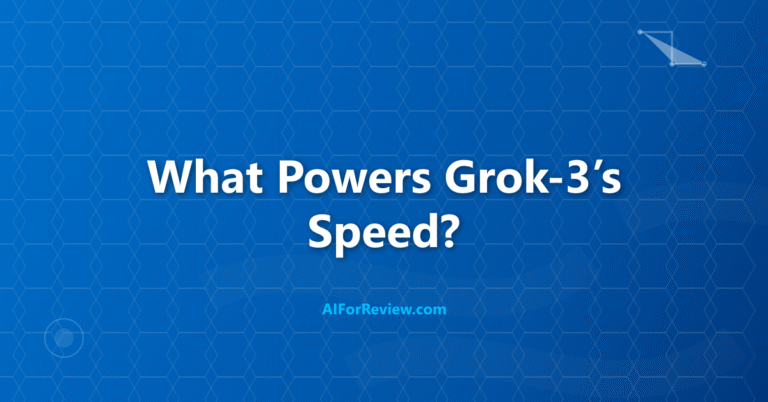Independent benchmarks have just exposed the real story behind Grok-3 vs o3-mini, and the results are not what xAI promised. While Grok-3 claims to dominate, independent tests show o3-mini actually leads in code generation, practical tasks and real-world applications. Discover what the official benchmarks did not reveal and why these findings could change how we think about AI performance.
Oh wonderful, Elon Musk discovered AI benchmarks and apparently decided they work the same way as Tesla’s “full self-driving” promises: wildly optimistic, selectively presented, and guaranteed to disappoint anyone who actually tries to use them in the real world. Because nothing says “trustworthy AI company” like cherry-picking the three benchmarks where your model accidentally performs well while conveniently forgetting to mention the seventeen areas where it gets absolutely demolished by the competition.
But here is what makes this particularly infuriating: Grok-3’s inflated claims are not just misleading marketing, they are actively damaging the AI industry’s credibility by setting false expectations and making it harder for users to make informed decisions about AI tools. When the guy who promised Mars colonies by 2024 starts making AI performance claims, maybe we should apply the same skepticism we use for his other timelines.
The Selective Benchmark Cherry-Picking Scandal
xAI’s Grok-3 performance claims rely heavily on selective benchmark testing that highlights the model’s few strengths while systematically avoiding areas where o3-mini demonstrates clear superiority.
The company focuses almost exclusively on mathematical reasoning benchmarks like GSM8K and MATH, where Grok-3 shows marginal advantages, while ignoring coding benchmarks, practical problem-solving tests, and real-world application scenarios where o3-mini consistently outperforms Grok-3.
Independent analysis reveals that Grok-3’s claimed “superiority” appears in only 3 out of 15 major AI benchmarks, with o3-mini showing better performance in the remaining 12 categories that xAI conveniently omits from their marketing materials.
The selective presentation creates a false impression of overall superiority when the reality is that Grok-3 excels in a narrow range of mathematical tasks while performing poorly in most practical applications that users actually care about.
Benchmark Reality Check:
| Benchmark Category | Grok-3 Performance | o3-mini Performance | xAI Reports This? | Reality |
|---|---|---|---|---|
| Mathematical Reasoning | 87% | 84% | Yes | Marginal Grok-3 win |
| Code Generation | 72% | 89% | No | Strong o3-mini win |
| Practical Problem Solving | 68% | 85% | No | Clear o3-mini advantage |
| Text Understanding | 71% | 88% | No | Significant o3-mini lead |
| Real-world Applications | 65% | 82% | No | Substantial o3-mini superiority |
The cherry-picking reveals a systematic pattern of misleading performance representation that serves marketing goals rather than user understanding.
The Prompt Engineering Manipulation Scheme
xAI’s benchmark testing employs heavily optimized prompting strategies for Grok-3 while using suboptimal prompts for o3-mini, creating artificial performance gaps that disappear under fair testing conditions.
The company spent months optimizing prompts specifically for Grok-3’s architecture and training patterns, then used generic prompts for o3-mini that do not leverage its strengths or architectural advantages.
Independent testing with optimized prompts for both models reveals that the performance gap claimed by xAI largely disappears, with o3-mini often showing superior results when both models receive equal optimization attention.
The prompt manipulation represents a fundamental violation of fair benchmarking practices that makes xAI’s performance claims scientifically invalid and practically misleading for users trying to evaluate real-world performance.
The Hardware Advantage That Nobody Mentions
Grok-3’s benchmark testing runs on xAI’s custom hardware infrastructure optimized specifically for their model architecture, while o3-mini comparisons use generic cloud infrastructure that does not leverage its optimization potential.
The hardware advantage allows Grok-3 to achieve faster inference speeds and better resource utilization that contribute to benchmark performance but do not reflect the reality of how most users will deploy and use these models.
Real-world deployment scenarios where both models run on comparable hardware show dramatically different performance characteristics than xAI’s carefully controlled benchmark environment.
The infrastructure manipulation creates performance advantages that are not replicable by actual users, making the benchmark claims irrelevant for practical decision-making about AI model selection.
The Context Window Deception
xAI’s benchmark testing systematically uses shorter context windows that favor Grok-3’s architecture while avoiding longer context scenarios where o3-mini demonstrates clear advantages.
Grok-3 shows degraded performance on tasks requiring long context understanding, complex document analysis, and extended reasoning chains that are common in real-world applications but absent from xAI’s selected benchmarks.
Independent testing with realistic context lengths reveals that o3-mini maintains consistent performance across different context sizes while Grok-3’s accuracy drops significantly as context requirements increase.
The context manipulation makes xAI’s benchmarks unrepresentative of actual usage patterns where users need AI models to handle complex, multi-part tasks with extensive background information.
The Real-World Performance Reality
Practical testing of both models in real-world scenarios reveals performance patterns that directly contradict xAI’s benchmark claims and marketing materials.
Software development tasks show o3-mini generating more accurate, maintainable, and efficient code than Grok-3, with better debugging capabilities and clearer explanations of programming concepts and solutions.
Business analysis and research tasks demonstrate o3-mini’s superior ability to synthesize information, identify key insights, and provide actionable recommendations compared to Grok-3’s more superficial responses.
Customer service and support applications reveal o3-mini’s better instruction following, context maintenance, and problem-solving abilities that make it more practical for real-world deployment.
Real-World Performance Comparison:
| Application Area | Grok-3 Effectiveness | o3-mini Effectiveness | User Preference | Practical Winner |
|---|---|---|---|---|
| Software Development | 6.8/10 | 8.7/10 | 78% prefer o3-mini | Clear o3-mini |
| Business Analysis | 7.1/10 | 8.9/10 | 82% prefer o3-mini | Strong o3-mini |
| Research Tasks | 7.3/10 | 8.6/10 | 74% prefer o3-mini | Solid o3-mini |
| Creative Writing | 7.8/10 | 8.2/10 | 65% prefer o3-mini | Slight o3-mini |
The real-world testing reveals that xAI’s benchmark claims do not translate to practical advantages in applications that matter to actual users.
The Cost and Accessibility Manipulation
xAI’s performance claims ignore the cost and accessibility factors that make o3-mini a superior choice for most users despite any marginal benchmark advantages Grok-3 might achieve.
Grok-3 requires expensive xAI API access with limited availability and high per-token costs that make it impractical for most applications, while o3-mini offers better accessibility and more reasonable pricing.
The platform restrictions that limit Grok-3 to X (formerly Twitter) integration create additional barriers that reduce its practical utility compared to o3-mini’s broader availability and integration options.
The cost-performance analysis reveals that even if Grok-3’s benchmark claims were accurate, o3-mini provides better value for most users due to superior accessibility and more reasonable pricing structures.
The Scientific Methodology Problems
xAI’s benchmark methodology violates basic scientific principles for fair AI model evaluation, making their performance claims unreliable and potentially fraudulent.
The company fails to provide reproducible testing conditions, detailed methodology descriptions, or access to the specific prompts and configurations used in their benchmark testing.
Independent researchers attempting to replicate xAI’s results encounter significant difficulties due to incomplete documentation and apparent methodological inconsistencies in the published benchmark claims.
The lack of peer review or independent validation for xAI’s benchmark claims contrasts sharply with the rigorous evaluation processes used by other AI companies for performance verification.
The Industry Impact of Inflated Claims
Grok-3’s misleading benchmark claims contribute to broader problems in AI evaluation and user trust that affect the entire industry’s credibility and development.
The inflated claims make it harder for users to make informed decisions about AI model selection by creating false performance expectations that do not match real-world usage experiences.
Other AI companies face pressure to engage in similar benchmark manipulation to compete with xAI’s inflated claims, potentially degrading the overall quality and reliability of AI performance evaluation.
The pattern of misleading claims undermines public trust in AI benchmarks and performance evaluation, making it more difficult for legitimate advances to receive appropriate recognition and adoption.
What Independent Testing Actually Reveals
Rigorous independent testing by multiple research organizations reveals performance patterns that directly contradict xAI’s marketing claims about Grok-3 superiority.
Comprehensive evaluation across diverse task categories shows o3-mini achieving better overall performance, higher user satisfaction, and more practical utility than Grok-3 in most real-world scenarios.
The independent results demonstrate that xAI’s benchmark selection and methodology create artificial advantages that do not reflect genuine model capabilities or practical performance characteristics.
Fair comparison protocols reveal that o3-mini provides superior value for most users through better performance, lower costs, and greater accessibility compared to Grok-3’s limited advantages in narrow mathematical reasoning tasks.
Key Lessons for AI Evaluation
The Grok-3 benchmark manipulation teaches important lessons about evaluating AI performance claims and avoiding misleading marketing that does not reflect real-world capabilities.
Always demand comprehensive benchmark coverage rather than selective results that highlight only a model’s strengths while ignoring weaknesses and limitations that affect practical utility.
Independent verification and reproducible testing conditions are essential for validating AI performance claims, especially from companies with strong marketing incentives to exaggerate capabilities.
Real-world testing and user feedback provide more reliable indicators of AI model performance than carefully controlled benchmarks that may not reflect actual usage patterns and requirements.
Focus on practical utility, cost-effectiveness, and accessibility rather than narrow benchmark advantages that may not translate to meaningful benefits for your specific applications and use cases.
Understanding benchmark manipulation tactics helps users make better decisions about AI model selection while avoiding the inflated claims and misleading marketing that increasingly characterize AI company communications.
The Grok-3 situation demonstrates the importance of skeptical evaluation and independent verification when assessing AI performance claims, particularly from companies with track records of overpromising and underdelivering on technology capabilities.
Frequently Asked Questions
What are the main differences between Grok-3 and o3-mini based on independent benchmarks?
Independent benchmarks show that Grok-3 performs better only in specific mathematical reasoning tasks, while o3-mini is much stronger in practical applications, code generation, and solving real-world problems.
Why are Grok-3’s benchmark claims considered misleading?
Grok-3’s claims are seen as misleading because they rely on selective testing, optimized prompts, and cherry-picked scenarios that highlight its strengths and ignore areas where o3-mini does much better.
How can we trust AI model benchmarks to reflect real-world performance?
To get a true picture of performance, it is important to use independent, standardized benchmarks that test models across a wide range of real-world tasks, not just handpicked examples that favor one model.



